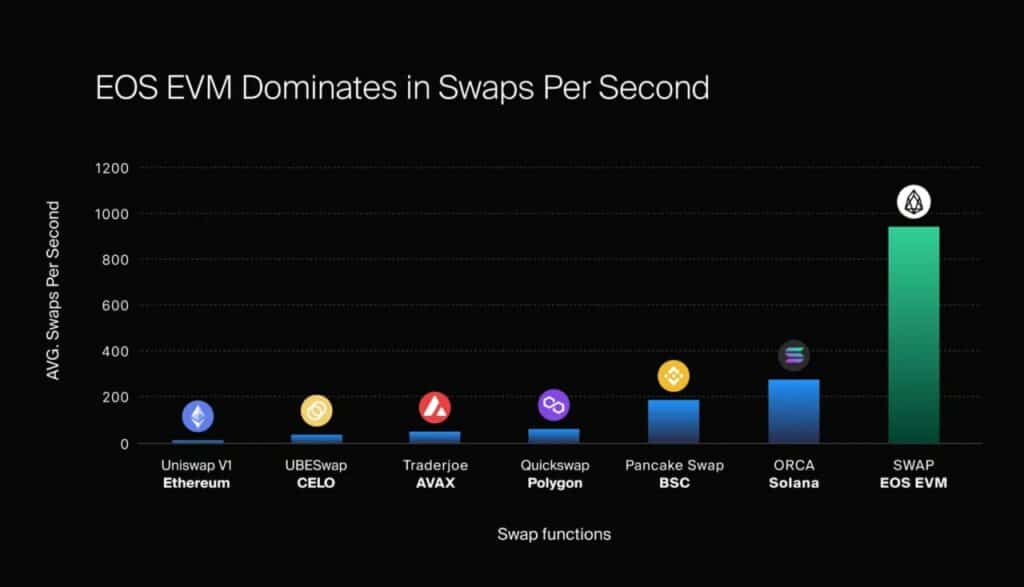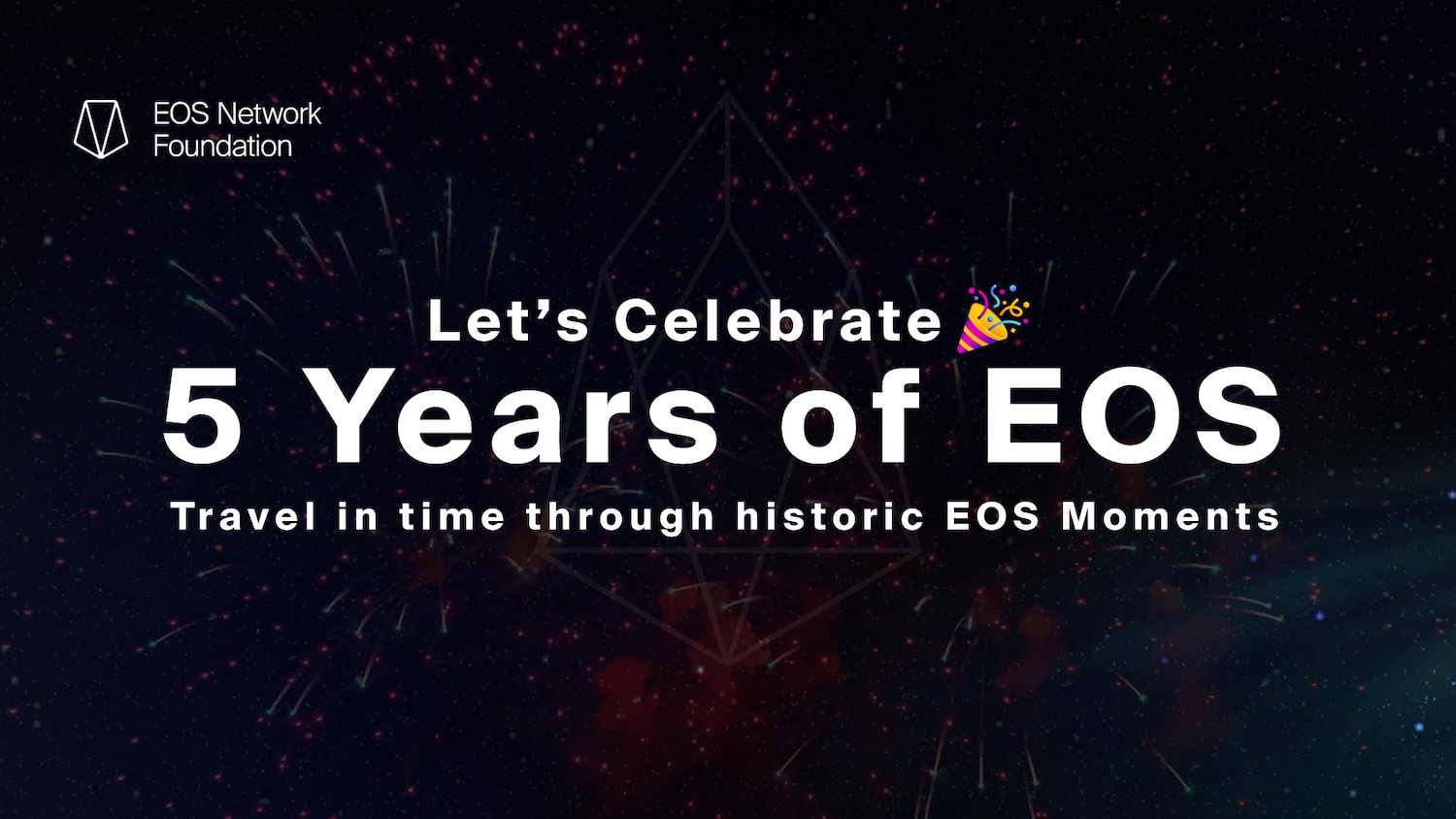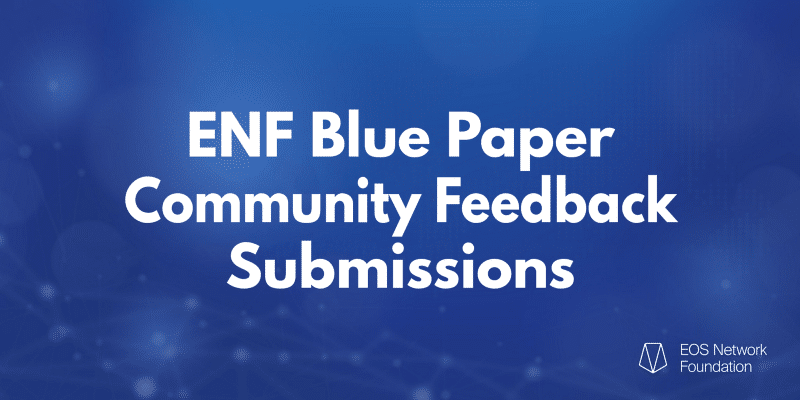Today marks the 5 year anniversary of the launch of the network, and with an impressive track record of 1,800+ consecutive days without any downtime, EOS has proven itself to be the most reliable highly performant blockchain network in the world.
With breathtaking performance of over 100M+ transactions per day, as well as technological breakthroughs like the fastest EVM on the market and a trustless IBC solution, the EOS Network offers a unique feature set that cannot be found anywhere else in crypto.
On top of its technical accomplishments, EOS also has a vibrant community that exemplifies the core values that attract vibrant and hopeful human beings to the web3 space. Values such as the desire for independence, the preference for collaboration, and the ability for a community to unite and build together are ever-present in the EOS community. In today’s brief history of EOS, we’ll showcase a community that’s eager to build, ready to unite, and willing to battle!
Let’s start at the beginning, shall we?
While today marks the 5 year anniversary of the first confirmed block on June 8, 2018 at 8:08 AM, 8.888 seconds UTC, many consider the official EOS birthday to be the chain activation on June 14 when the 15% voting threshold was reached.
1st EOS Community Conference — User Agreement — The Launch of REX
The energy in the community was electric and a few short months after launch, in July of 2018, the community was drawn together for the first EOS Community Conference. Held in Seoul, Korea, the conference helped form enduring relationships within the EOS community of investors, builders, and block producers. The following year, in April of 2019, network consensus was reached and the EOS User Agreement was signed into effect by the leading block producers.
On-chain, in early 2019, the community bonded by passing around a blockchain torch. Off-chain, our top blockchain scholars were meeting up all around the world, both online and offline, for a series of great hackathons.
In May 2019, the Resource Exchange Protocol (REX) unlocked nearly uncontrollable scalability on the network. Token holders could now rent out their unused capacity to power users, increasing both the utility and yield of the EOS token.
2nd EOS Community Conference — The Great CPU Battle — EOS Ranks #1 in China
Next came the second EOS Community Conference, this time held on the other side of the world in Rio, Brazil in October 2019. This spark reignited collaboration and strengthened soon-to-be tested bonds within the ecosystem.
In January 2020, the EOS Network encountered a situation that would test the resiliency, redundancy, and capacity of the network. How strong is the EOS Network? Would it be able to withstand the onslaught of the CPU miners?
The epic on-chain Battle for CPU lasted months and the grueling battle tested many parts of the EOS ecosystem all at once. Core devs shipped specific protocol features to help mitigate the attack and node operators worked tirelessly to strengthen, optimize, and reorganize the structure of their nodes in order to withstand an outrageous number of transactions.
Eventually, the network emerged victorious! Now able to process over 100M tx/day, the network could easily handle the CPU miners. The ponzinomics powering the attack eventually fizzled out and the once-loud CPU miners left quietly into the night.
These impressive feats of blockchain engineering did not go unnoticed. The China Centre for Information Industry Development (CCID) has published multiple global rankings of public blockchains. Based on their technical assessments, the EOS Network has consistently ranked in first place.
The Dark Ages of EOS — Birth of the EOS Network Foundation!
The EOS Network, now the most powerful, robust, and reliable blockchain network in existence, was ready for mass adoption. But another challenge was on the horizon. And this time it would not be technical in nature. It would be political, and it would be emotional.
For two years, the community waited in vain for Block.one to fulfill its promises of meaningfully investing in the EOS community. Attempts to gaslight the community led to initiatives being paused or sometimes never even attempted. EOS ecosystem builders were given false hopes of funding, strung along, and then ghosted. These were the dark ages of EOS.
And then, in August 2021, after a long period of misguided hope and patience, the EOS community was hungry and ready for something new. Emerging from this deep and widespread desire for change, leadership, and action, the EOS Network Foundation was born.
Public Goods! — Pomelo — The Blue Papers
Since the EOS Network Foundation was founded by, the EOS Network has seen a flurry of activity, including financing critical research, implementing a wide range of funding opportunities for EOS ecosystem builders of all kinds, and hiring the best developers in the space to ensure EOS remains on the bleeding edge of Web3.
One such funding mechanism is Pomelo. Through the magic of quadratic funding, the Pomelo crowdfunding platform has empowered the EOS community to support and fund hundreds of projects they love. Season 6 has just started and we invite you to get involved if you’d like to receive funding for building public goods on EOS! Follow Pomelo on Twitter and join the community discussions on Telegram today!
Funding builders of all kinds is great, but knowing exactly what to build is of course very important. To that end, the commissioning of seven Blue Papers allowed the most active and knowledgeable participants of the network to set roadmaps that laid out the future vision and direction of the chain around various aspects, such as API+, Audit+, Core+, Recover+, Scalability+, Wallet+ & Yield+.
A Web3 Community Uprising
On December 7, 2021, after months of negotiations between block producers, the ENF, and Block.one, the EOS Network reached consensus and stopped the vesting of the Block.one tokens that had been promised in exchange for maintaining the protocol codebase and meaningfully investing in the EOS ecosystem. In true web3 fashion, the community fought off a bad actor, and the industry took notice.
“Never doubt that a small group of thoughtful committed individuals can change the world. In fact, it’s the only thing that ever has.”
—Margaret Mead, EOS genesis block memo
Direct Grant Framework — Antelope Coalition — EOS Code Independence
Having been starved of resources, the network needed to find a way to fund its best developers. In December 2021, the milestone-driven Direct Grant Framework was announced with a focus on open source development. The Direct Grant Framework unlocked access to previously unavailable, higher levels of funding for builders.
A major milestones for the EOS community is when it forked the old EOSIO codebase into the community-owned and community-maintained Antelope protocol and declared independence. This allowed the network to take its destiny completely into its own hands. It also unified the EOS, WAX, Telos & UX ecosystems through aligned incentives and the new Antelope Coalition.
On September 21, 2021, the new Antelope blockchain protocol was ready for prime time. The EOS Network upgraded from the neglected EOSIO codebase to the community-improved Antelope protocol. This marked EOS Independence Day and an exciting and significant new chapter for the community.
Global Conference Circuit — Antelope IBC — EOS EVM
Armed with a tremendous track record of action and execution, the EOS Network Foundation and Zaisan Global embarked on a world tour in late 2022 to showcase the recent achievements of #TheNewEOS and promote upcoming technical developments. The EOS story resonated with investors, paving the way for future deals and significant partnerships.
In January 2023, the much-anticipated and long-awaited Antelope IBC solution was released. This trustless solution integrates directly into the Antelope base layers and seamlessly connects the EOS, WAX, TELOS & UX networks. United at last!
Not long after that, on April 14th, 2023, the EOS EVM launched as the fastest EVM on the market with a staggering 950 swaps per second, was launched on EOS. Are you considering launching your app on EOS EVM? Make sure to apply for your share of the $20M+ in funding available for EVM projects!

After learning about this epic EOS blockchain story and adventure, it should come as no surprise that some of the biggest names in crypto are now taking a second look at EOS and announcing significant partnerships. Binance, Messari, DWF Labs, and even the city of Busan, South Korea recognize the potential of the #TheNewEOS and are positioning themselves to be aligned with EOS and its undeniable potential.
Opening Your Anniversary NFT Crate or Capsule
If you received an EOS Moments Capsule or EOS Moments Crate through a community activity, you can open it up to see what Historical EOS Moment is captured inside! All you have to do is transfer the NFT to the account: unpack.gems
After sending it to the account, an EOS Moment NFT representing one of the historical events described in this blog post will be returned to your account. An easy way to transfer the NFT is to open it on eos.atomichub.io, by logging in with a wallet such as Anchor or Wombat. Once logged in, navigate to the “Inventory” section of your account, open the NFT you’d like to unpack, scroll down and select “Transfer”. After entering the account unpack.gems you can sign the transaction with the same wallet you used to log in.
In case it wasn’t yet crystal clear, EOS is in the midst of an epic narrative reversal and #TheNewEOS has the potential to become the biggest comeback story of 2023! Join the adventure!
EOS Network
The EOS Network is a 3rd generation blockchain platform powered by the EOS VM, a low-latency, highly performant, and extensible WebAssembly engine for deterministic execution of near feeless transactions; purpose-built for enabling optimal Web3 user and developer experiences. EOS is the flagship blockchain and financial center of the Antelope framework, serving as the driving force behind multi-chain collaboration and public goods funding for tools and infrastructure through the EOS Network Foundation (ENF).
EOS EVM
The EOS EVM is an emulation of the Ethereum EVM, housed within an EOS smart contract. It offers feature parity to other EVMs in the space but with unmatched speed, performance and compatibility. EOS EVM connects the EOS ecosystem to the Ethereum ecosystem by allowing developers to deploy a wide array of Solidity-based digital assets and innovative dApps on EOS. Developers can use EOS EVM to take advantage of Ethereum’s battle-tested open source code, tooling, libraries and SDKs, while leveraging the superior performance of EOS.
EOS Network Foundation
The EOS Network Foundation (ENF) was forged through a vision for a prosperous and decentralized future. Through our key stakeholder engagement, community programs, ecosystem funding, and support of an open technology ecosystem, the ENF is transforming Web3. Founded in 2021, the ENF is the hub for EOS Network, a leading open source platform with a suite of stable frameworks, tools, and libraries for blockchain deployments. Together, we are bringing innovations that our community builds and are committed to a stronger future for all.



